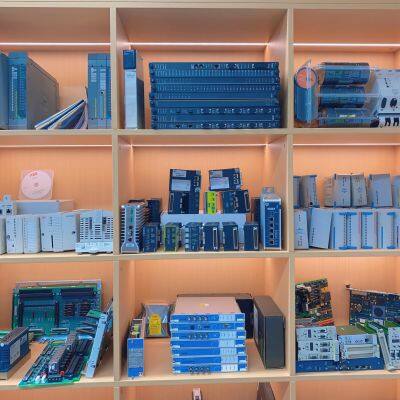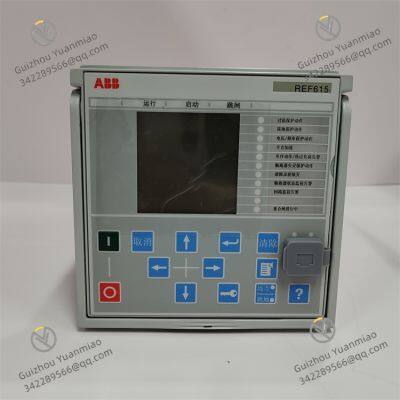Product Description
I. Overview
ABB REF615C_E
HCFFAEAGANB2BAA11E is a feeder protection and control relay belonging to the Relion series. It is mainly used for the protection, control, measurement, and monitoring of overhead lines and cable feeders in utility and industrial distribution systems. It is suitable for radial, ring, and mesh distribution networks with or without distributed generation. As a member of the 615 protection and control product series, it occupies an important position in the field of medium and high-voltage power systems due to its compact structure and withdrawable unit design. This product is developed in strict accordance with the IEC 61850 standard, demonstrating excellent performance in realizing communication and interoperability between substation automation equipment, and strongly promoting the construction and development of smart grids.

II. Technical Parameters
Electrical Parameters
Operating Power Supply: It has strong power adaptation capability. The AC operating voltage can run stably in the range of 85-265V AC, and the DC operating voltage range is 85-300V DC. This wide-range power input design ensures that it can adapt to various complex and changing substation power supply conditions, continuously providing reliable power for the stable operation of each functional module inside the device.
Rated Frequency: It has strong global versatility and is compatible with two frequency standards, 50Hz and 60Hz. In power systems in different regions, it can accurately ensure that the accuracy of protection and measurement functions is not disturbed by frequency differences, and normally exert its performance advantages.
Power Consumption: Adhering to the concept of energy conservation, the product has low power consumption. The typical power consumption is no more than 25VA when powered by AC, and no more than 25W when powered by DC. The low-power characteristic not only helps reduce energy consumption but also effectively reduces the heat generation during the operation of the device, thereby prolonging the service life of the equipment and improving the overall operational stability.
Measurement Parameters
Current Measurement: In terms of current monitoring, it provides a rated current option of 1A or 5A, with extremely high measurement accuracy, and the error is controlled within no more than 0.2%. This enables it to accurately capture the subtle changes in current of the busbar and related lines, providing extremely accurate current data support for protection decisions and ensuring the safety of power system operation.
Voltage Measurement: For different application scenarios, the rated voltage can be flexibly selected, such as common specifications like 100V and 220V. In the voltage measurement link, it also maintains a high level of accuracy, with a measurement error of no more than 0.2%, which can accurately measure the busbar voltage, timely and accurately judge voltage abnormalities, and ensure the voltage stability of the power system.

Environmental Parameters
Operating Temperature: It has extremely strong environmental adaptability, with a wide operating temperature range, from the extremely cold environment of -40℃ to the high-temperature environment of +70℃, and can operate stably. Whether it is a cold northern substation, a hot southern substation, or a plateau substation with significant temperature differences, it can continuously and stably perform the busbar protection function without being affected by extreme temperature changes.
Relative Humidity: It performs excellently in humidity adaptability and can work normally in an environment with a relative humidity of 5%-95% (non-condensing). The interior of the device adopts an advanced moisture-proof design, and the internal circuit is subjected to special moisture-proof treatment, which effectively resists the erosion of the circuit by humid air. Therefore, it can also operate reliably in environments such as substations in humid coastal areas or rainy areas.
Anti-vibration Performance: In dealing with vibration interference, it can withstand vibrations with a frequency range of 10-2000Hz and an acceleration of 15g. In the common vibration environment during the operation of substation equipment, it can still maintain normal working performance without being affected, ensuring that the protection function plays a stable and reliable role, and Protect and escort for the stable operation of the power system.
Communication Parameters
Communication Interfaces: To meet diverse communication needs, it is equipped with multiple Ethernet interfaces and RS-485 interfaces. The Ethernet interface supports 10/100M adaptive, enabling high-speed data transmission with the substation automation system, ensuring the timeliness and efficiency of data interaction; the RS-485 interface supports common communication protocols such as Modbus, facilitating data exchange and information sharing with other intelligent devices, and improving the overall communication compatibility of the system.
Communication Protocols: It fully supports the IEC 61850 communication protocol, which enables it to achieve seamless communication and interoperability with other intelligent devices that comply with this standard, strongly promoting the construction of an intelligent substation information management platform. At the same time, it also supports other common communication protocols such as Modbus, DNP3, and IEC 60870-5-103, further expanding its communication capabilities, improving networking flexibility, and adapting to power systems with different communication architectures.

III. Functional Characteristics
Reliable Busbar Protection Functions
Differential Protection: It adopts an advanced busbar differential protection algorithm, which can quickly and accurately judge whether a busbar fault occurs by accurately comparing the vector sum of currents in each branch of the busbar. Once a busbar fault occurs, it can act quickly to reliably cut off the faulty busbar. Its protection range is comprehensive, and the action speed is extremely fast, effectively avoiding the further expansion of the fault and minimizing the impact of the fault on the power system.
Failure Protection: It has the circuit breaker failure protection function. When the circuit breaker refuses to operate, this function can quickly detect the abnormality and timely activate relevant protection measures to cut off the busbar or line where the fault is located, effectively preventing the spread of accidents and significantly improving the safety and reliability of the power system.
Dead Zone Protection: Aiming at the problem that dead zone faults are prone to occur between current transformers and circuit breakers, a special dead zone protection function is set. This function can quickly detect and cut off such faults, ensuring the comprehensiveness and reliability of busbar protection, and eliminating potential safety hazards in the operation of the power system.
Accurate Measurement and Monitoring Functions
Real-time Measurement: It can measure various electrical parameters such as current, voltage, and power of the busbar in real-time and synchronously, and use high-precision algorithms to conduct in-depth processing and analysis of these parameters. The measured data can be uploaded to the substation automation system in real-time, providing operators with comprehensive, accurate, and timely information on the operating status of the busbar, helping operators better grasp the operation of the power system and make scientific decisions.
Event Recording: It has a complete and powerful event recording function, which can record various fault events, operation events, alarm events, etc. in detail. The recorded content not only includes the time and type of the event but also includes detailed information such as relevant parameters, with high recording accuracy. These rich event records provide crucial basis for fault analysis, accident recall, and system operation evaluation, helping to quickly locate the root cause of problems, summarize experience and lessons, and improve the operation and maintenance level of the power system.
Status Monitoring: It can conduct all-round and real-time monitoring of its own operating status, including power supply status, communication status, working status of internal components, etc. Once any abnormal situation is detected, it can immediately send an alarm signal to remind operation and maintenance personnel to carry out maintenance in a timely manner, effectively improving the reliability and availability of the device, and reducing the outage time of the power system caused by equipment failures.

Flexible Control and Operation Functions
Local Control: Operators can conveniently perform local operations through the human-machine interface (HMI) equipped with the device, such as modifying protection settings, controlling circuit breakers, and other key operations. The human-machine interface adopts an intuitive graphical design, and the operation process is simple and easy to understand, which greatly facilitates operators to quickly master and operate, reduces the difficulty of operation, and improves work efficiency.
Remote Control: It supports remote control function through the communication network. Operators can remotely operate and set parameters of the device in the substation control center without being present on-site. This function significantly improves the automation level and operation efficiency of the substation, reduces the workload and labor cost of on-site operations, and also improves the timeliness and accuracy of operations, facilitating unified scheduling and management of the power system.
Powerful Communication and Networking Capabilities
High-speed Communication: It uses high-speed Ethernet communication technology, with extremely fast data transmission rate, which can fully meet the transmission needs of protection information and measurement data with high real-time requirements. In the complex operating environment of the power system, it ensures the timely and accurate transmission of information, providing strong communication guarantee for the stable operation and rapid response of the power system.
Redundant Communication: It supports communication redundancy configuration. When the main communication link fails, it can automatically and seamlessly switch to the backup communication link, ensuring that the continuity and reliability of communication are not affected. This redundant communication design greatly improves the stability of the entire substation automation system, effectively reduces the risk of system out of control caused by communication failures, and ensures the continuous and stable operation of the power system.
ABB 1MRK002133-ABr02 Analog Digital Module
ABB UNITROL1020 Excitation Systems
ABB UNS0119A-Z,V1 3BHE030579R0001 Excitation Systems
GE VMIVME-017807-414001 350-0001007807-414001 D Single-Board Computer
GE VME7865RC V7865-23003 350-9300007865-230003 M Single-Board Computer
GE IS210BPPCH1AEC Power Supply Module


GE IS210BPPCH1AD Printed Circuit Board
GE IS200AEPAH1BKE Printed Circuit Board
GE IS215WEPAH2BB Printed Circuit Board
GE IS410JPDHG1A Pack Power DIN Rail Modul
GE IS200VPROH2B Emergency Turbine Protection Board
GE IS200VPROH1BEF Emergency Turbine Protection Board
GE IS200VPWRH1AHD Emergency Turbine Protection Board
GE IS200EAUXH1AAA Auxiliary Tri-Redundant Circuit Board
GE 889-EP5P5G5HNNAANGMSFB3ASNBN - Generator Protection Relay Module
GE IS200ESYSH1AAA EX2100e Series Excitation System I/O Board
GE IC695PBM300 PROFIBUS DP Master Module
GE IC687BEM742-EB I/O Expansion Module
GE PCH1026 CHF 891069 Digital Structural Vibration Monitor
GE IS200EAUXH1AAA Mark VIe Series Circuit Board Module
GE IS420UCECH1B Core Controller Module
GE IS220YDOAS1A Safety Discrete Output I/O Module
SCHNEIDER C400/10/1/1/1/00 C400 Controller
SCHNEIDER C200/10/1/1/1/00 High-performance Motion Control Module
 yezi
Hi there! Welcome to my shop. Let me know if you have any questions.
yezi
Hi there! Welcome to my shop. Let me know if you have any questions.






